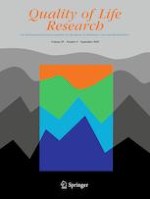20-06-2020
Health gap for multimorbidity: comparison of models combining uniconditional health gap
Gepubliceerd in: Quality of Life Research | Uitgave 9/2020
Log in om toegang te krijgenAbstract
Purpose
The aim of this study is to identify the best-fitting model in predicting the health gap of multimorbid status based on the health gap of uniconditional status.
Methods
This study analyzed data of adults aged 50 years or older derived from the cross-sectional, nationally representative 6th Korean National Health and Nutrition Examination Survey (KNHANES). We translated the EQ-5D utility score assessed from the KNHANES using the Korean EQ-5D-3L into the health gap by subtracting the EQ-5D utility score from one. The predicted health gap of multimorbid status was calculated based on the health gap of uniconditional status using the additive, multiplicative, and maximum limit models. We assessed the performance of the multimorbidity adjustment models based on the root mean square error and mean absolute error. We also examined the impact of multimorbidity adjustment on the estimated disease burden in the best-fitting model.
Results
Of the three approaches, the multiplicative adjustment model had the smallest root mean square error between the predicted and observed health gap of multimorbid status. The total number of prevalence-based years lived with the disability after adjusting for multimorbid status using the multiplicative model decreased compared to that without adjustment for multimorbid status.
Conclusion
Using the appropriate methodology to adjust for multimorbidity in estimations of population health is becoming more important as the prevalence of multimorbidity increases, particularly in older populations. Further empirical research is required to develop additional general adjustment approaches that consider the independent co-occurrence of multiple diseases, and to understand how multimorbidity influences health gap.
